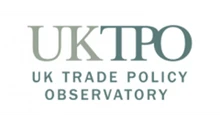Customs checks, differences in regulation and border delays have negatively affected EU-UK trade since Brexit. They’ve also cut the number of active firms and weakened competition. A range of policies could alleviate the effects: reducing the costs of firm entry is likely to have the biggest impact.
The post-Brexit Trade and Cooperation Agreement signed between the European Union (EU) and the UK on 30 December 2020 preserved tariff-free trade.
Nevertheless, it did introduce a range of non-tariff barriers (NTBs). These include customs checks, rules of origin requirements, regulatory divergence, border delays and restrictions on services – all of which have created persistent bilateral trade frictions.
New research investigates how these NTBs influence firm-level decisions and spread through the wider macroeconomy (Economides et al, 2025). One central mechanism is the way that elevated trade costs reduce the number of active firms and weaken market competition. These dynamics magnify Brexit’s economic toll significantly by dampening competitive pressures and eroding productive capacity (the economy’s potential output given its resources).
To address the damage, a range of policy responses could be rolled out. Some of these are theoretically capable of fully offsetting the Brexit-related costs, while others offer partial relief.
The former includes optimal but politically and practically challenging measures, such as per-unit subsidies for labour, imported intermediate inputs and capital, alongside a lump-sum subsidy to firms – all funded by a lump-sum household tax.
Recognising the limitations of this approach, more feasible alternatives include reducing the costs of firm entry, increasing tax deductions for new investment, expanding public investment, subsidising labour costs and supporting capital acquisition.
With neither major UK political party advocating a return to the EU, domestic policy must carry the full burden of economic adjustment. From this analysis, four key lessons emerge:
- Firm dynamics are crucial: Brexit’s consequences extend beyond trade costs, undermining competition and firm entry.
- Support is needed for firm creation, not just firm survival: policies that lower entry barriers are more effective than broad-based subsidies. (Here, it is worth noting that UK businesses face various expenses beyond corporation tax and VAT, including employers’ national insurance contributions, business rates, the apprenticeship levy, Companies House filing fees, licensing and compliance fees, and other sector-specific levies and operational taxes. Most of these constitute government revenues and are treated as such in our analysis.)
- Targeted interventions outperform blanket spending: focused measures deliver greater impact than general public investment.
- Fiscal realism matters: successful policy design must balance economic goals with budgetary and political constraints.
How has Brexit affected the UK economy?
Since the global financial crisis of 2007-09, labour productivity growth (output per worker or hour worked) in the UK has slowed dramatically. In the decade preceding the crisis (1998-2007), productivity grew at an average annual rate of 1.6%. From 2008 onwards, this figure fell sharply to just 0.2% a year. Current projections remain subdued, with GDP growth forecast at only 1.4% in 2026 (International Monetary Fund, IMF, 2025).
While Brexit is not the sole driver of the UK’s economic malaise, its impact has been substantial. Heightened uncertainty, the reintroduction of border controls and new trade barriers have increased business costs, reduced competitive pressures and constrained innovation by limiting access to foreign resources and technologies (Ahn et al, 2019). Estimates suggest that these effects have lowered average firm-level productivity by between 2.3% (Latorre et al, 2020) and 4% (Office for Budget Responsibility, OBR, 2020).
Other disruptive events have further compounded the low-growth environment. The Covid-19 pandemic, supply chain disruptions, inflationary pressures and geopolitical instability, particularly following Russia’s full-scale invasion of Ukraine, have all added to the challenges that UK businesses face.
Figures 1 and 2 provide additional insight into the post-Brexit investment climate, highlighting the role of regulatory burdens in shaping market competitiveness. Figure 1 presents indices that measure bureaucratic costs and business regulation. Falls in these scores signal rising compliance costs, which deter new entrants and force some firms to exit the market, thus weakening competition.
Figure 1: Product market competition
Source: Fraser Institute, Economic Freedom
Similarly, Figure 2 illustrates a general deterioration in regulatory quality (the lower the index, the lower the quality of regulation). Poor regulation fosters uncertainty, inefficiency and market distortions, undermining the conditions necessary for healthy competition and sustained productivity growth.
Figure 2: Regulatory quality
Source: World Bank, Worldwide governance indicators
Note: World Bank definition: ‘Regulatory quality captures perceptions of the ability of the government to formulate and implement sound policies and regulations that permit and promote private sector development’. More details on the variables and sources are available on the World Bank website.
The decline in UK competitiveness, as implied by Figures 1 and 2, is further reinforced by the post-Brexit rise in average mark-ups, as shown in Figure 3. Mark-ups – defined as the ratio of a firm’s output price to its unit cost of intermediate consumption (the total value of goods and services used in production) – serve as a proxy for a firm’s ability to influence prices (its market power).
The upward trend in these mark-ups signals a shift towards a less competitive market structure, with firms able to charge higher prices relative to their costs. This erosion of competitive pressure disadvantages consumers (reduces consumer surplus) and can lead to inefficient allocation of resources. Importantly, Figure 3 reveals that this increase in market concentration is not confined to a single sector: it is broad-based, affecting both services and manufacturing.
Figure 3: Average mark-ups
Source: Office for National Statistics, Trends in UK business dynamism and productivity
To offer a rough indication of how Brexit may have influenced net firm creation, Figure 4 charts the number of private businesses in the UK from 2013 to 2023. Panel A presents the overall trend, showing steady growth until a peak of nearly six million firms in 2020. Panel B focuses on the post-2020 period, highlighting a sharp decline in business numbers. Specifically, the number of firms fell to 5.5 million in 2022 and 5.55 million in 2023, representing declines of 8.3% and 7.5%, respectively, from the 2020 peak.
Figure 4: Number of private businesses, 2013-23
Source: UK.GOV, Business population estimates
It is important to emphasise that Figure 4 does not imply that Brexit was the sole driver of the observed decline. The pandemic was another shock that precipitated a severe economic slowdown, exerting substantial adverse effects on business operations and firm survival. Consequently, the trends depicted in Figure 4 reflect the combined influence of both Brexit and Covid-19, among other factors, across various sectors of the UK economy.
Sectoral patterns underscore this dual impact. Industries such as financial services, manufacturing, transport and travel, agriculture and food, and consumer-facing sectors saw more firms close, as well as a decline in new firm formation during the Brexit period.
Regulatory changes, trade frictions, labour shortages and reduced investment primarily drove these outcomes. In contrast, sectors more directly affected by the pandemic – particularly hospitality, retail and leisure – were disproportionately affected by lockdown measures and shifts in consumer behaviour.
Research highlights a countervailing trend: firm entry in the UK increased during the pandemic, primarily due to the rapid expansion of the online retail sector, one of the few areas to benefit from Covid-19-induced shifts (Bahaj et al, 2024). The pandemic’s impact on business activity presents a somewhat paradoxical picture. While a surge in business closures might have been expected, this did not materialise.
In 2020, corporate bankruptcy filings in most advanced economies, including the UK and other OECD countries, declined by 17% relative to 2019, with even larger reductions compared with earlier years (Zhang and Djankov, 2021). This decline suggests that initial policy responses – such as fiscal support, loan guarantees and temporary insolvency relief – were effective in averting a wave of bankruptcies.
Accordingly, while the downward trend in the number of private enterprises from 2020 onwards is likely to reflect the interplay between Brexit and the pandemic, sectoral evidence and the policy context suggest that Brexit-related uncertainty and structural changes may have played a more decisive role in driving the contraction in firm numbers.
That said, this interpretation remains provisional. A more definitive assessment of the relative contributions of Brexit and Covid-19 would require rigorous data analysis to disentangle the effects of these overlapping shocks and to control for confounding factors.
What does research suggest about the long-term effects of Brexit?
To assess the long-term macroeconomic effects of Brexit on the UK economy, we can use analysis that accounts for new firm entry, price mark-ups and market competition, allowing us to trace how Brexit-induced trade frictions reshape firm behaviour, market structure and overall economic performance.
A substantial body of research has examined the economic implications of Brexit. Some studies have explored the effects of uncertainty surrounding trade policy and foreign direct investment (Ebell et al, 2016; Steinberg, 2019; Bloom et al, 2019; McGrattan and Waddle, 2020). More recent work has broadened the scope, including work to investigate the role of macroprudential policy in both Brexit and non-Brexit scenarios (Rubio, 2024), and to analyse Brexit as a negative shock to expected future productivity in the tradable goods sector (Broadbent et al, 2024).
Another study that is closely aligned to our work uses a three-country analysis that incorporates, like ours, endogenous (not driven by external factors) firm entry and exit (Millard et al, 2024). Our approach builds on this foundation but diverges in two key respects. First, we emphasise the quantitative importance of mark-ups and market competition arising from Brexit-induced trade cost distortions. Second, we explicitly analyse the role of policy interventions in mitigating the macroeconomic fallout from these distortions.
(Other recent, non-technical summaries of the effects of Brexit on the economy are provided by Kaya et al, 2023, 2024; and econometric analyses of Brexit’s economic effects appear in Bloom et al, 2019 and Minford and Zhu, 2024. Broader assessments of Brexit’s macroeconomic and productivity impacts have been published by institutions including the Bank of England, the National Institute of Economic and Social Research, the OBR and the Productivity Institute – see Economides et al, 2025 for further details.)
Firm exit and reduced product variety
Our analysis demonstrates that rising trade costs, whether through increased import frictions or export barriers stemming from Brexit, diminish firm-level profitability in the product market. As profitability falls, the number of active firms declines. This contraction in firm numbers has several adverse effects:
- Reduced product variety: fewer firms result in a narrower range of intermediate and final goods available to consumers and producers, thereby reducing both welfare and productive efficiency.
- Declining capital accumulation: a smaller firm base translates into lower overall (aggregate) investment, dampening long-run per capita GDP.
Weaker competition and rising mark-ups
A decline in firm numbers also weakens competition. In our analysis, this reflects an endogenous rise in market power and price mark-ups. Elevated mark-ups introduce several macroeconomic distortions:
- Allocative inefficiency: higher mark-ups widen the gap between prices and marginal costs, misallocating resources across firms and sectors.
- Lower real wages and consumption: as firms capture a greater share of output via increased mark-ups, the share going to workers declines, suppressing household spending/consumption.
Amplification through feedback effects
Crucially, there is a feedback loop between firm exit and rising mark-ups that amplifies the costs of trade frictions across the economy as a whole. As firms exit, competitive pressures weaken, allowing mark-ups to increase further. This in turn reduces profitability and discourages new entry. The resulting self-reinforcing dynamic deepens the transitional losses and leads to a permanently lower trajectory for per capita output, relative to a setting with fixed firm numbers and pricing power.
These results highlight the importance of considering endogenous firm dynamics and market structure in evaluating the long-term economic impact of Brexit. The costs of trade frictions are not merely static: they are endogenously magnified through the erosion of competitive forces and productive capacity.
How might policy reduce these effects?
While we were able to design a policy mix – combining per-unit and lump-sum subsidies, financed by a lump-sum tax on households to restore the pre-Brexit allocation of resources in full – implementing such a solution is challenging in practice. These kinds of taxes and subsidies may be conceptually simple, but they are far more challenging to execute effectively (Barro and Sala-i-Martin, 2004).
In particular, the government would need not only to target the appropriate inputs for subsidisation, but also to fund those measures through non-distortionary taxation (taxation that doesn’t change the behaviour of individuals and firms), an inherently complex task in real-world policy environments.
Given these practical limitations, we turn to a set of more feasible policy interventions aimed at mitigating the economic damage. Specifically, we consider measures such as permanently reducing the fixed costs of firm entry, increasing tax allowances for new investments, expanding public investment and raising per-unit subsidies on labour and capital.
Among the policy options we consider, reducing the fixed cost of firm entry stands out as the most effective intervention for mitigating the long-term economic impact of Brexit. It consistently delivers the highest gains across all financing schemes, achieving more than half the improvement associated with a complete reallocation of resources.
Our analysis of policies aimed at encouraging firm entry reveals several important insights:
- Lowering firm entry costs enhances economic performance by stimulating new business creation, increasing market competition and elevating per capita GDP in both the short and long term. But by eroding government revenue, particularly from entry-related taxes, this policy creates a fiscal gap that may lead to longer-term budgetary challenges.
- Debt financing enhances policy outcomes when the stabilising tax instrument is relatively non-distortionary (in other words, it has less of an effect on taxpayers’ behaviour). For example, using a combination of debt and consumption taxes to fund lower entry costs yields slightly higher gains than relying solely on consumption taxes. Debt enables smoother tax adjustments over time, contributing to higher GDP, more active firms and lower mark-ups in the short to medium term. When managed responsibly, public debt can thus play a constructive role in improving outcomes.
- Income tax financing, while potentially yielding slightly higher welfare due to increased leisure, tends to be less effective in stimulating key macroeconomic indicators. Its relatively high distortionary effects make it a weaker option for promoting firm entry. Moreover, combining income taxes with debt alone offers slightly less additional benefits compared with income tax financing alone.
- The welfare gains from boosting firm entry are substantial and consistent across financing strategies, accounting for more than half the gains observed under the optimal policy mix. This reform clearly outperforms all alternative policies, establishing it as a robust and strongly dominant policy choice.
Conclusions
Our research analyses the key macroeconomic effects of Brexit and evaluates policy responses capable of mitigating their negative impact. By focusing solely on trade shocks, we are able to explain the observed economic changes without resorting to additional external factors (exogenous disturbances), which would be harder to rationalise.
The analysis captures a wide range of mechanisms beyond the conventional effects of rising trade costs on firm behaviour, including a reduction in the number of active firms, increased price mark-ups and diminished market competition. These outcomes emerge endogenously and align well with empirical evidence.
Using this framework, we quantify the additional economic damage arising from these endogenous responses. Their inclusion leads to an estimated 1% further decline in GDP, a 2.3% drop in the number of active firms, and a 0.5% rise in price mark-ups. As a result, the consumption-equivalent welfare cost of Brexit for UK households increases from 2.7% to 3.1%.
Having identified an optimal tax-subsidy scheme capable of fully offsetting Brexit’s adverse effects, we turn to more realistic policy alternatives aimed at restoring pre-Brexit levels of per capita GDP. These interventions involve significant trade-offs and incur fiscal costs, highlighting the need for a commitment to fiscal responsibility. Among them, reducing firm entry costs is the most effective strategy, consistently recovering more than half of the welfare loss across all financing approaches.
As with any work rooted in complex real-world dynamics, our analysis is necessarily partial. The UK’s productivity challenges, which predate the global financial crisis, underscore the importance of future research that incorporates Brexit and related policy responses within an endogenouslong-term growth framework. This framework should explicitly capture the evolution of productivity and identify engines of medium- and long-term growth. We view this direction as both promising and essential for a more comprehensive understanding of Brexit’s long-run implications.
Where can I find out more?
- Policy interventions to mitigate the long-run costs of Brexit: CESifo working paper, 2025.
- Business population estimates for the UK and regions: Department for Business and Trade.
- Trends in UK business dynamism and productivity: Office for National Statistics.
- Worldwide governance indicators: World Bank.
- The real effects of Brexit on labour demand: VoxEU article, 2025.
- How Brexit affected the trade of UK firms: LSE blog article, 2024.
- Deep integration and trade: UK firms in the wake of Brexit: Article from UK in a Changing Europe.
Who are experts on this question?
- Jun Du
- George Economides
- Jim Malley
- Apostolis Philippopoulos
- Jonathan Portes
- Anastasios Rizos
- Thomas Sampson









































